Oman: The new diving frontier of the Middle East
Words and Photography by Scott & Lauren Johnson
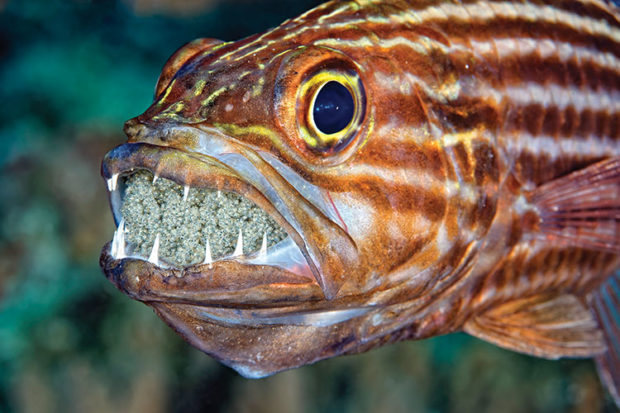
A back-roll off one of the Oman Aggressor’s two 22-foot (6.7m) tenders leaves me descending into the unknown and onto a previously unexplored site off Al Hallaniyah Island in Oman’s remote Hallaniyat Islands’ archipelago. The top of the seamount below me rises to within 20 feet (6m) of the surface, but its naturally hewn, uneven sides stairstep into the surrounding depths. With no discernible current and a good 70 feet (21m) of visibility, I decide to survey the area fairly high in the water column in order to cover more terrain.
Leisurely fining over a rolling plateau of hard corals and rugged rocks adorned with stalks of radiant soft corals, I see the glowing, telltale white spots of an eagle ray 30 feet (9m) below me. The graceful ray is slowly gliding along as if strolling in the park and, best of all, seems unaware or uncaring of my presence. With a gravitational assist, I descend at a 45º angle to within only a few feet of the eagle’s back and then fire a series of shots before the startled ray flaps away.
Gradually working my way further around and back up the northern flank of this underwater mountain, I am treated to another set of spots in the form of a busy leopard (zebra) shark. Most people probably do not think of sharks as cute, but that is what comes to mind as I draw closer. And, most definitely, hungry, as this rather small, two-foot (60cm) carpet shark is obviously looking for a snack, since its elongated caudal fin is pointed toward the sky and its wriggling head is in a crevice. I spend the remainder of the dive with this “I’ve got the munchies” leopard as it thoroughly combs the reef for something to eat and offer, “Bon Appétit!” when my computer lets me know times up. Ascending, I wonder, “What comes next?” as I look forward to the next dive in Oman’s vast marine wilderness.
The largest school of fusiliers I have seen outside of Komodo suddenly crushes me on all sides
Desert tears
2,000 years before Magi from the East (wise men) presented their precious gifts to the infant Jesus, caravan trails were already being etched in the desert floor as aromatic sap from scraggily Boswella trees in the mountainous region now called Dhofar in Oman was ferried to eager traders in port cities and then sold throughout the known world. This sap, called desert tears or frankincense, once held such demand that it was valued more highly than gold. It was used for religious offerings, to consecrate temples, as medicine (due to antiseptic and anti-inflammatory properties), as an ingredient in mummification and for more mundane purposes, such as cosmetics, incense, and perfume.
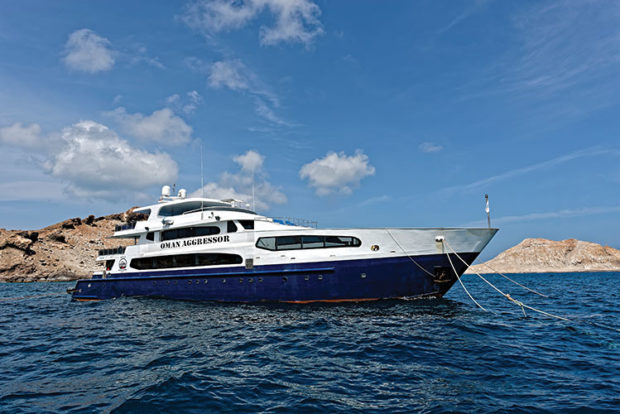
The Sultanate of Oman, which is bordered to the west by the United Arab Emirates, Saudi Arabia, and Yemen, respectively, and elsewhere by the Gulf of Oman to the northeast and the Arabian Sea to the southeast, was birthed from this vast maritime trade of desert tears. Oman is an absolute monarchy that allowed few outsiders within its borders until a1970 interfamily coup gradually began to transform Oman’s economy, infrastructure, and desire to cultivate tourism. Now the country is heralded as the Middle East’s new diving frontier. From endemic marine species, such as Oman anemonefish, Oman butterflyfish, and Oman cuttlefish, to virgin dive sites, Oman offers “off the beaten path” experiences day and night.
God willing
I confess, I do not notice much of the passing scenery during the half hour ride from Salalah International Airport to the Juweira Boutique Hotel, which is my temporary, pre-charter home for the day. My head bobbles back and forth like some possessed bobblehead doll as I struggle to keep puffy, travel-weary eyes from closing for a nice long siesta. But, then, in a very slow blink of these same eyes, my exhaustion washes away when I finally arrive and notice unusual hanging bird nests in what looks to be some species of crape myrtle near the hotel’s main entrance. Bright yellow male and plain brown female Ruppell’s weaver birds tend to the elaborately woven, gourd-shaped nests and the hungry chicks within each of them. Invigorated, I hand my bags to the concierge, put a lens on one of the camera bodies and lose myself in the surreal avian community.
My pre-arranged guide arrives a couple of hours later, introduces himself as Ahmed and then takes me on a tour of the natural beauty of West Salalah. The topography changes from stark rocky mountains in the north to a rock/sand mixture of flat to rolling terrain that bleeds into Arabian Sea to the South. We transverse winding switchbacks at speeds that have me white-knuckling the SUV’s handrests. Ahmed mumbles “Inshallah” (God willing) at least once in every sentence. I do not know if this is because he is a devote Muslim or subconsciously fears his own driving. Regardless, I sure hope God is willing Ahmed returns me safely to the hotel. We occasionally stop so I can photograph points of interest, such as a herd of camels walking along an open stretch of road, Frankincense (Boswella) trees “crying” desert tears and lonely beach scenics of this holiday haven.
Each and every dive represents an opportunity to discover something new, something breathtaking
Shortly after boarding and goggling at the impressive (understatement) new Oman Aggressor, which is docked in an equally shiny Salalah marina complex not for from the legendary Dhofar mountains, I ask Shaker Mohamed what I should expect to see over the next two weeks. Mohamed smiles, shakes his head and offers, “Diving is new to Oman. Every dive is, how you say, an exploration dive here. So, we are boldly going where no diver has gone before.” I thank him and excitedly start to prep for an adventure of discovery.
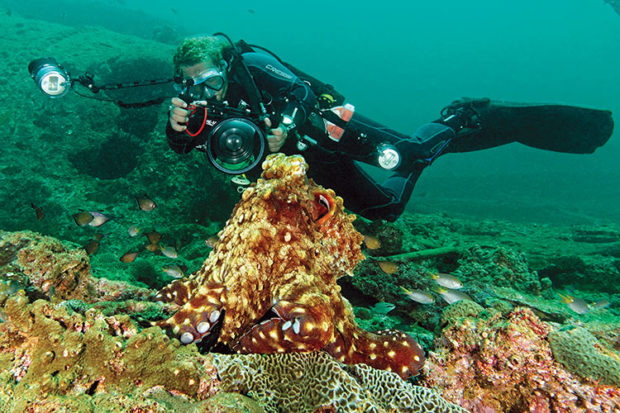
Our check-out dive at Ras Mirbat reveals an aquatic environment rife with action and colour. An enormous green sea turtle ringed by swirling cardinalfish looks at me as if to say, “What’s up?” as I take my initial bearings. Not far away, two octopuses sit on either side of a half-eaten fish carcass and barely flinch when Mohamed bathes them with his video lights. And, then, around 55 feet (17m), Naomi Le Vot-Bovy, a guide and the only non-Egyptian crew member, points into a low-ceiling ledge and shows me something truly spectacular. Peering inside, there seems to be four eyes staring back at me. I remove my Sola Photo 1200 light from the housing, turn on its red beam (so as not to scare the object of my curiosity), place it on the mouth of the opening to my right and then look again. I am utterly amazed to see the jittering, flattened head of an endemic two-faced toadfish as it grumbles at my intrusion. The subsequent images I capture are of an almost mythical creature few people know exist.
Omani tattoos
The Marriott Wreck was so named because of the Marriott Resort on the nearby Mirbat beach. The wreck is over 100 years old, yet no one seems to know the ship’s identity or history. The same is true for an estimated 50 or more unidentified shipwrecks in these waters. What is known about the Marriott Wreck is that it is a diver’s playground.
A night dive on the shallow-water wreck can be exhilarating, but also prickly. Yellow-lipped, brown eel catfish energetically serpentine across and under much of the structure, while other inhabitants are simply trying to get some sleep. My left hip bumps against a couple of long-spine black urchins as I try to focus on one of the scurrying fish. The resulting sharp pain prompts me to flail my right knee into another armor-piercing urchin and leaves me feeling like a pin cushion. I eventually stop grimacing and am treated to more scorpionfish, slipper lobsters, and hunting blue spotted rays than I have previously seen on a lone site. Once back aboard the mothership, I gently crawl into bed with two painful Omani tattoos that will eventually fade and vivid memories that will certainly linger.
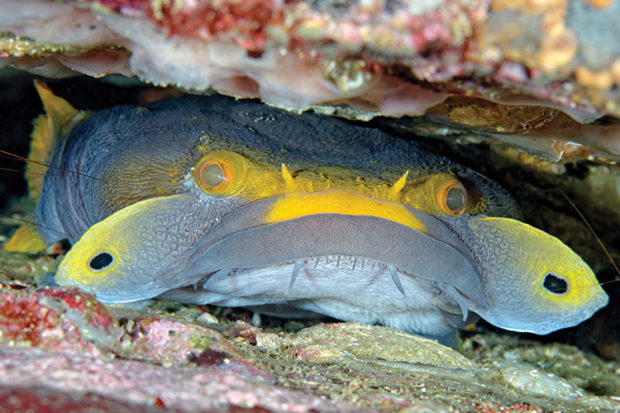
If laughter truly is the best medicine, then our return to the wreck the next morning will cure all my ailments. About fifteen minutes into the dive, a supersized, free swimming honeycomb moray passes in front me on a collision course with Paul Flandinette, a vacationing British expat living in Oman’s capital city of Muscat, who currently has his head down in part of the fractured superstructure trying to photograph something. The massive, spotted honeycomb parts Flandinette’s hair as it passes, which, of course, causes the surprised diver to spew bubbles with bulging eyes. I lose 1/3 of my tank of air as I belly laugh until I cry.
When my eyes clear enough for me to see again, I swim towards a group of blue-barred parrotfish that are milling about a splintered sliver of the hull. The brilliantly-hued parrotfish seem to be celebrating life as they whirl around one another. A giant hogfish appears upside down in front of lounging parrotfish, which spooks it and causes it to swim away. The jokester hogfish then rights itself and settles on the departed parrotfish’s comfy bed as if signaling “mission accomplished”.
Diving is new to Oman. Every dive is an exploration dive here. So, we are boldly going where no diver has gone
At the far end of the wreck, I come across an abandoned wooden, igloo-shaped fish trap packed with parrotfish, longfin bannerfish, bronze-striped grunts and many other helpless victims. I carefully set my housing aside and begin trying to dismantle the death trap. Eventually, Sayed Mostafa, another of the Oman Aggressor’s keen-eyed guides, and other divers notice my plight and rush over to help. Together, we release the desperate captives and then watch them disperse throughout the wreck.
The dragon’s lair
A 105-mile (170km), 11-hour cruise from Salalah carries us to Al Qibliyah Island, the most easterly island in the Hallaniyat Island chain and thus the farthest from the mainland. Al Qibliyah Rock is known to host at least one dragon moray, which is target #1 for the upcoming dive. I ask if any of the other guests want to help me look for the special moray and Marina Goodyear volunteers.
Temporary holes open within dense, mixed schools of lemon sweetlips, minstrel sweetlips, twobar seabream and yellowfin goatfish as Marina and I swim through them. The sheer density of the marine life here more than offsets the reduced visibility of the nutrient-rich water. Taking our time, we check every visible hole and crevice we find. Omani waters must contain more eels per square foot than any other place on the planet and the expansive, boulder-strewn slope of this site is no exception. We pass multiple honeycomb, yellowmouth, and grey morays as we seek the dragon’s lair.
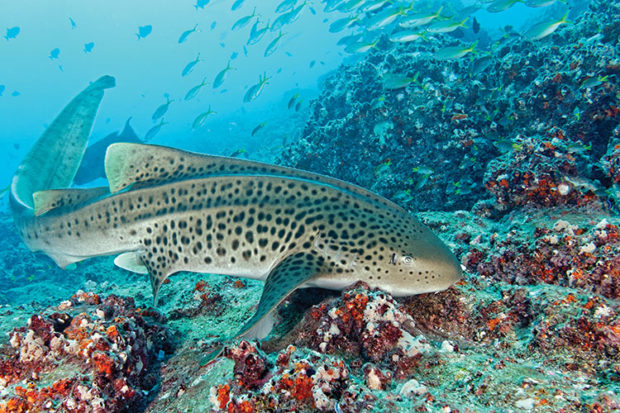
Our hunt finally proves fruitful when Marina tugs my right arm and points to a dragon extending from the shelter between two large rocks at 60 feet (18m). I give Marina a big thumbs up and then carefully approach the ornately patterned eel. Striped hingebeak shrimp line the lair and occasionally venture onto the moray’s textured skin to clean it. Just as I am about the squeeze the shutter on the framed dragon and its attending retinue of shrimp, the focus distorts. I look up to find a grey moray positioned between me and the dragon as if trying to convince me to take its picture instead. The delightful odd couple keeps me blissfully entertained until I notice a small, yellow, polka-dotted cube floating between the spines of an urchin. The juvenile yellow boxfish is just another in a seemingly endless of living marine collection of Omani spotted treasures.
Size matters
The dive at Fish Highway, which is located between Al Hallaniyah Island and Schmies (an islet) is both an epic experience and an epic fail. The swim from the dive deck to the mooring line is relatively short, but it seems to magically transport me from a sea of water to a sea of fish. The largest school of fusiliers I have seen outside of Komodo suddenly crushes me on all sides. I am stunned. Absolutely stunned. Unfortunately, the 24-70mm lens I am wielding is not nearly wide enough to capture the magnitude of the living fishy walls that enclose me. There is no way I can swim back to the mothership against the current, change lenses, have the tank topped off and then return before this mesmerizing moment dissipates. So, I continue to watch helplessly as Fish Highway drives home the point that it is aptly named.
Al Qibliyah Rock is known to host at least one dragon moray, which is target #1 for the upcoming dive
The shallow night dive between Schmies Fingers and Schmies Wall continues of my string of amazing dives and poor lens choices when a robust pharaoh cuttlefish appears beside me as I search along the sand for something small to shoot. Not only is the cuttlefish curious, it is largest cephalopod I have encountered during the trip. I sigh as the curious cuttlefish tries to use my light as a hunting aid. I sigh yet again when another cuttlefish about half the size of the first arrives and starts trying frisky with the larger one. Obviously, the smaller is a male and the larger a female. The female seems torn between passion and hunger as she morphs back into hunting mode every time a darting fish passes within the beam of my light. Perhaps the petite male will eventually have more success than I managed today.
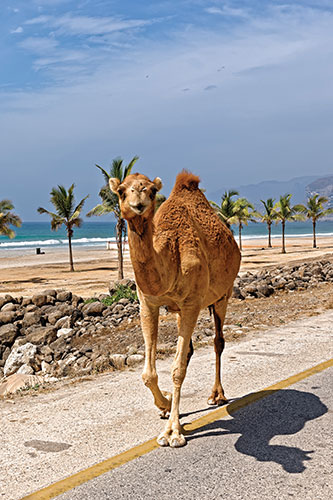
To boldly (and repeatedly) go
Each and every dive from either the Oman Aggressor’s spacious dive platform or one of its tenders represents an opportunity to discover something new, something breathtaking. Come to think of it, the same holds true for the surface intervals, as well. For example, crew members and guests are ever hopeful of spotting a breaching or spouting Arabian humpback between dives. These endangered cetaceans likely represent the world’s only nonmigratory and most isolated pod of humpbacks. From desert tears to dragons’ lairs to mysterious humpbacks, Oman truly offers adventure-seeking divers the chance “to boldly go where no diver has gone before.”
Good to Know:
Getting there:
International flights typically access the three host cities from either Doha or Dubai.Departure tax is usually included in the airfare.Visas are valid for only 30 days from date of issue and cost approximately $50 U.S. per person.
When to go: The Oman Aggressor operates a Hallaniyat Islands itinerary from the Juweira Boutique Hotel & Marina in Salalah from October through April, a Musandam Peninsula itinerary from the Khasab Port Marina in Khasab each May, and a Daymaniyat Islands itinerary from the Al Mouj Marina in Muscat from June to September.
Dive with: The Oman Aggressor www.aggressor.com
Top Tip: To stay in-touch with family and business partners while at sea, rent an Iridium GO! The author’s came from Satmodo www.satmodo.com







